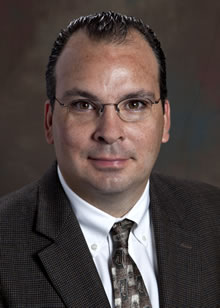
Ioannis Sechopoulos
How much radiation is actually delivered to the glandular tissue in a person's breast during an imaging test? It's surprising to learn that there has never been a way to accurately make those measurements on an individual basis.
Thanks to a nearly $1 million grant from Susan G. Komen, medical physicist Ioannis Sechopoulos, PhD, hopes to answer that question using the new screening technique of tomosynthesis. Sechopoulos is an investigator in the Glenn Family Breast Center at Winship Cancer Institute of Emory University and in the Department of Radiology and Imaging Sciences at Emory University School of Medicine.
Radiation exposure in mammography screening has been estimated based on a hypothetical breast model that doesn't exist in nature. This measurement works well for quality control and for comparing imaging technologies, but it doesn't provide patient-specific information.
"For the last 30 years, we've been estimating radiation dose based on a hypothetical breast with a homogeneous make-up of glandular and fat tissues, but every individual breast is structured differently," says Sechopoulos.
"Tomosynthesis enables us to map the actual structure of a person's breasts. The next step is to use those measurements to calculate radiation dose for every individual."
Sechopoulos has spent years researching the issue of radiation dose. He says the research enabled by the Komen grant should generate methodology and data that will ultimately help calculate individual screening doses that deliver the best imaging without exceeding the safety limit.
"I'm glad to be moving forward with this research. It's closer to clinical application, not just theory," says Sechopoulos.
Breast tomosynthesis (tomo) is a new technology that produces a three-dimensional set of x-ray mammography slices. It offers better visibility than conventional mammography because it doesn't result in an image with superimposed tissue within the breast. According to the Food and Drug Administration (FDA), tomosynthesis delivers approximately the same radiation dose as conventional mammography. The three-dimensional aspect of the imaging enables researchers to estimate the radiation dose throughout the breast.
The Susan G. Komen environmental grants foster research in understanding the role of toxins and other environmental factors that may contribute to breast cancer. According to the organization, this "real" radiation dose information could then be used to establish nationwide standards and provide researchers with improved information with which to analyze the benefits and risks of breast cancer screening.
"We are really pleased that Susan G. Komen is making such a significant investment in Dr. Sechopoulos's research into radiation dose in breast imaging," says Walter J. Curran, Jr., MD, executive director of Winship Cancer Institute. "He is leading the way by using tomosynthesis as a tool to increase our knowledge and improve our understanding of breast cancer."
